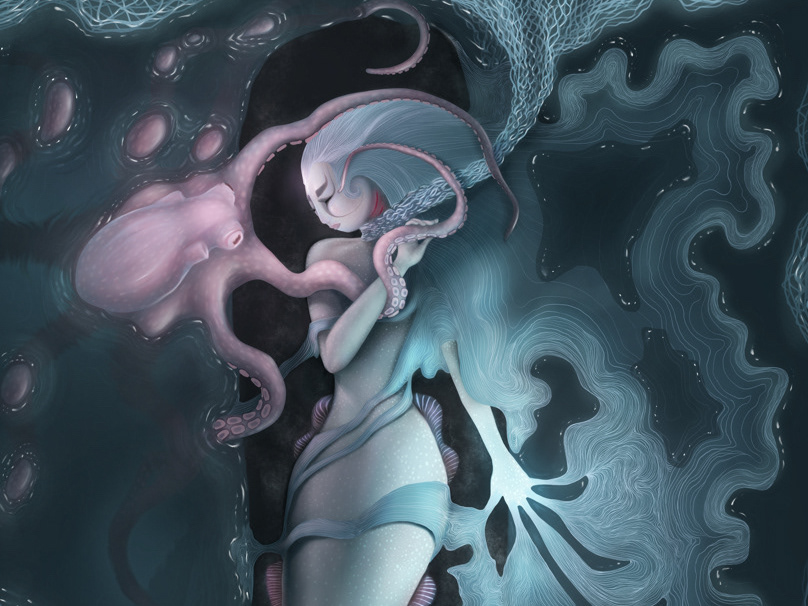Los Vigilantes Oscuros, or the Dark Watchers, are shadowy beings with glowing eyes that have been seen observing travelers along the Santa Lucia Mountains, most often during the twilight and dawn hours. They were first noticed by Spanish settlers, and there is no mention of them in Chumash and other local Indigenous histories before colonization. The feeling people have reported getting when being observed by a Dark Watcher is chilling; while it is not believed that they are dangerous, it is not clear whether or not they are benevolent - at least to those whose lineages derive from colonization and/or settler-colonialism.
In the foreground is a portrait of Korean Buddhist nun Jeung Kwan Sunim, who I had the opportunity to visit and learn from at the Baekyangsa Monastery in 2018. Her hermitage is up in the mountains, close to an enshrined cave and sacred spring. She is a famed chef whose chosen meditation is food, and the beauty of the food she creates emanates from her relationship to the forest and mountains around her.
Rabbits, in many indigenous traditions but particularly in my Slavic and Baltic pre-Christian traditions, are a sacrificial totem. We often think of rabbits and their connection to fertility - but it goes beyond procreation into the essence of life and death itself. One rabbit represents multitudes, including numerous births and deaths. If a rabbit is sacred to your personal path (as it is to mine), you may experience many rebirths on your journey.
Personally, I learned how to harvest rabbits as a part of homesteading, and the experience forced me to meet mortality in its purest form, uncloaked by euphemism and conceptual distance. It made me deeply question nonviolence and consuming animals, as rabbit harvesting is much kinder to the planet than buying meat in a grocery store but also much more confrontational. I've metabolized this experience through my connections to Buddhism and in particular Mahayana Buddhism, which is a vegan tradition, as well as my connections to Indigenous paths that consume animals in a way that respects and honors their beingness. All of this is what I was synthesizing in the imagery of this painting.
Los Vigilantes Oscuros, también conocidos como los 'Dark Watchers,' son seres sombríos con ojos brillantes que se han visto observando a los senderistas a lo largo de la cordillera de Santa Lucía, más a menudo durante la madrugada y el crepúsculo. Primero fueron notados por los colonizadores españoles, y no hay mención de ellos en Chumash y otras historias indígenas locales antes de la colonización. La sensación que las personas han dicho tener cuando son observadas por un Vigilante Oscuro es escalofriante; no se cree que sean peligrosos, pero tampoco no está claro si son benévolos o no, al menos con aquellos cuyos linajes se derivan de la colonización.
En primer plano hay un retrato de la monja budista coreana Jeung Kwan Sunim, a quien tuve la oportunidad de visitar y aprender de ella en el Monasterio de Baekyangsa en 2018. Su ermita está en las montañas, cerca de una cueva consagrada y un manantial sagrado. Es una famosa chef cuya meditación predilecta es cocinar y preparar comida, y la belleza de la comida que crea emana de su relación con el bosque y las montañas que la rodean.
En muchas tradiciones indígenas, pero particularmente en mis tradiciones precristianas eslavas y bálticas, los conejos son un tótem de sacrificio. Los conejos simbolizan la fertilidad, pero con la procreación viene la esencia de la vida y la muerte. Un solo conejo representa multitudes, incluidos numerosos nacimientos y muertes. Si un conejo es sagrado en tu camino personal (como lo es para el mío), experimentarás muchos renacimientos en tu viaje.
Personalmente, aprendí a cazar conejos y con esa experiencia me encontré con la mortalidad en su forma más pura, sin eufemismo ni distancia conceptual. Me hizo cuestionar profundamente el consumo de animales, ya que cazar conejos es una obra violenta pero también es mucho más sostenible con el planeta que comprar carne en un supermercado. He procesado esta experiencia a través de mis conexiones con el budismo y, en particular, con el budismo Mahayana, que es una tradición vegana, así como con mis conexiones con los caminos indígenas que consumen animales de una manera que respeta y honra su ser. Todo esto es lo que estaba sintetizando en las imágenes de esta pintura.









